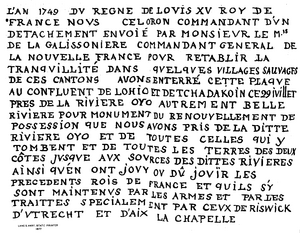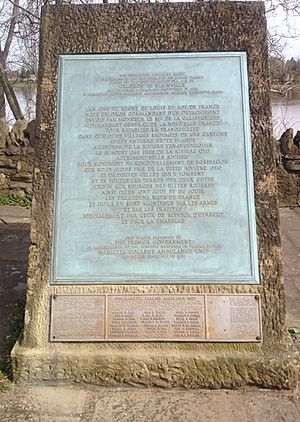Pierre Joseph Céloron de Blainville facts for kids
Pierre-Joseph Céloron de Blainville (born December 29, 1693, in Montreal; died April 14, 1759, in Montreal) was a French Canadian military officer. He was also known as Celeron de Bienville. He served as an Officer of Marine for France. In 1739 and 1740, he led a group of soldiers to Louisiana. Their mission was to fight the Chickasaw people in a campaign that did not fully succeed. In 1749, he led a famous journey called the 'Lead Plate Expedition'. This trip aimed to show that France owned the land in the Ohio Valley.
Contents
Life of Pierre-Joseph Céloron
Pierre Joseph Céloron de Blainville was born in Montreal on December 29, 1693. His parents were Jean-Baptiste Céloron de Blainville and Hélène Picoté de Belestre.
Céloron joined the military in 1713. The French often worked with Native American groups. They put pressure on the English colonies in New England. His first clear record shows him as a lieutenant commander. This was at Michilimackinac in 1734. He was likely appointed for a second term in 1737. But before that term ended, he was called to Louisiana.
Fighting the Chickasaw Nation
The Chickasaw nation lived in what is now northern Mississippi. They were allies with the British. The Chickasaw blocked travel between French Upper and Lower Louisiana. Bienville, who was the Governor of Louisiana, planned a large campaign against them. This was in 1739.
The Canadian government was asked for help. Céloron was sent to Fort de l'Assumption. This fort was near what is now Memphis, Tennessee. He brought many Native American allies from the north. He also had a company of young military officers called cadets. The soldiers stayed at the fort through the winter. They did not attack the Chickasaw villages, which were 120 miles away.
In March 1740, Céloron and his group finally set out. He had his cadets, one hundred regular soldiers, and many Native American allies. After some small fights, the Chickasaw agreed to make peace.
Serving in French Forts
After returning to Michilimackinac, Céloron was put in charge of Detroit. At this time, he was called a Chevalier of the Military Order of Saint Louis. He was also a Captain in the Department of Marine. In 1744, he was given command of Fort Niagara. In 1746, he commanded Fort St. Frédéric on Lake Champlain.
The 'Lead Plate' Expedition
From 1743 to 1748, Britain and France fought a war called King George's War. During this war, England blocked trade with New France. This hurt the French fur trade. The British then became the main trading partners with Native Americans in the Ohio Valley.
France said they owned the Ohio Valley. They also claimed the entire Mississippi River area. This claim was based on explorations by La Salle in 1669 and 1682. Great Britain also claimed the Ohio Valley. Their claim was based on land purchases from Native Americans in 1744. Both the colonies of Virginia and Pennsylvania claimed the Ohio Valley. Virginia was more active in pushing its claim in the 1740s and 1750s.
In March 1749, the Ohio Company of Virginia received land from King George. This land included 200,000 acres on the south bank of the Ohio River. This grant was meant to see if France would defend the Ohio Valley. This led to Céloron's expedition being sent from Montreal right away.
In 1748, Comte de la Galissoniere, the governor of Canada, ordered Céloron to make France's claim stronger. Céloron carried out this mission in the summer of 1749. He led an expedition through the disputed territory. He left Montreal on June 15, 1749. His group traveled in large boats and canoes. The expedition included 216 French Canadians and 55 Native Americans.
On the shore of Lake Erie, they reached the mouth of Chautauqua Creek. This is in present-day Westfield, New York. The expedition cut a road over the French Portage Road. They carried their boats and equipment overland to Chautauqua Lake. Then they followed the Chadakoin River and Conewango Creek to the Allegheny River. They arrived there on July 29, 1749.
Marking French Territory
As the expedition moved, it tried to strengthen France's claim. They marked the land at the mouths of several main rivers. At each spot, they nailed a tin or copper plate with the French royal arms to a tree. Below it, they buried a lead plate. This plate declared France's claims. This was a traditional European way to mark territory. However, it may have made Native Americans worried about the French. This might have worked against the French in the end.
The group boated past Shannopin's Town (where Pittsburgh is now). They continued down the Ohio River. They stopped at Kittanning. The village was empty except for a Lenape chief. They invited him to a meeting with Céloron at Logstown. At Logstown, in western Pennsylvania, Céloron found English traders. He was angry and forced the traders to leave. He also wrote a strong note to the governor of Pennsylvania. He then lectured the Native Americans about French control of the area. This bossy behavior offended the Iroquois in his group. Some of them went back to their homes in New York. They tore down copper plates as they left.
A lead plate was buried at the mouth of the Muskingum River on August 15, 1749. Another was buried at the mouth of the Kanawha River on August 18, 1749. On August 21, they reached Lower Shawneetown at the Scioto River's mouth. There, they again met English traders. Céloron called them to his camp on August 25. He demanded that they leave. He said they had no right to trade or do anything else on the Ohio River. But most of the traders refused to go.
The expedition then traveled up the Great Miami River to Pickawillany. They arrived there on September 13. They camped outside the village for a week. They met briefly with the chief Memeskia. He promised to think about moving closer to Detroit to be a French ally. Céloron later said that "the nations of these localities are very badly disposed towards the French, and are entirely devoted to the English." This meant the local Native American groups did not like the French. They preferred the English.
The expedition returned to Montreal on November 10, 1749. This was five months after they started. Céloron's journal from this trip is kept in Paris, France.
In total, Céloron buried at least six lead plates. One was stolen by curious Native Americans almost right away. It might have been taken before it was even buried. This plate ended up in British hands. Two more were found in the early 1800s. Each lead plate was about eleven inches long and seven and a half inches wide. They had a message carved into them.
|
L'AN 1749 DV REGNE DE LOVIS XV ROY DE |
In the year 1749, of the reign of Louis the 15th, King of |
| —CÉLORON, Plaque de Renouvellement de possession |
France continued to push its claim to the Ohio Valley. This conflict with the British colonies eventually led to the Seven Years' War.
Later Years and Death
After his expedition, Céloron was again appointed to the important post at Detroit. In 1753, he was promoted to Major. He was then appointed to Montreal. He died in Montreal on April 14, 1759.
Céloron's Family Life
Céloron had three children with his first wife, Marie Madeline Blondeau. They married on December 30, 1724. His second wife was Catherine Eury de la Parelle. They married in Montreal on October 13, 1743. They had nine children together.




